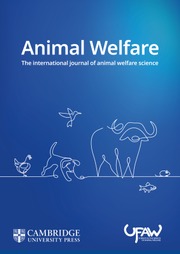Crossref Citations
This article has been cited by the following publications. This list is generated based on data provided by
Crossref.
Boyle, L.A.
and
O’Driscoll, K.
2011.
Food Chain Integrity.
p.
169.
O’Brien, Donal
Shalloo, Laurence
Patton, Joe
Buckley, Frank
Grainger, Chris
and
Wallace, Michael
2012.
A life cycle assessment of seasonal grass-based and confinement dairy farms.
Agricultural Systems,
Vol. 107,
Issue. ,
p.
33.
McCarthy, B.
Pierce, K.M.
Delaby, L.
Brennan, A.
and
Horan, B.
2012.
The effect of stocking rate and calving date on reproductive performance, body state, and metabolic and health parameters of Holstein-Friesian dairy cows.
Journal of Dairy Science,
Vol. 95,
Issue. 3,
p.
1337.
O'Brien, D.
Shalloo, L.
Patton, J.
Buckley, F.
Grainger, C.
and
Wallace, M.
2012.
Evaluation of the effect of accounting method, IPCC v. LCA, on grass-based and confinement dairy systems’ greenhouse gas emissions.
Animal,
Vol. 6,
Issue. 9,
p.
1512.
Mee, JF
2012.
Reproductive Issues Arising from Different Management Systems in the Dairy Industry.
Reproduction in Domestic Animals,
Vol. 47,
Issue. s5,
p.
42.
O'Brien, D.
Grainger, C.
and
Shalloo, L.
2013.
Making sense of methods to audit emissions – various audit methods to estimate dairy production carbon footprint.
Advances in Animal Biosciences,
Vol. 4,
Issue. ,
p.
2.
Díaz, J.R.
Alejandro, M.
Romero, G.
Moya, F.
and
Peris, C.
2013.
Variation in milk cortisol during lactation in Murciano-Granadina goats.
Journal of Dairy Science,
Vol. 96,
Issue. 2,
p.
897.
Nozad, Sh.
Ramin, A. G.
Moghaddam, Gh.
Asri-Rezaei, S.
and
Kalantary, L.
2014.
Monthly evaluation of blood hematological, biochemical, mineral, and enzyme parameters during the lactation period in Holstein dairy cows.
Comparative Clinical Pathology,
Vol. 23,
Issue. 2,
p.
275.
O’Brien, Donal
Brennan, Padraig
Humphreys, James
Ruane, Eimear
and
Shalloo, Laurence
2014.
An appraisal of carbon footprint of milk from commercial grass-based dairy farms in Ireland according to a certified life cycle assessment methodology.
The International Journal of Life Cycle Assessment,
Vol. 19,
Issue. 8,
p.
1469.
Faria, N.
and
Simões, J.
2015.
Incidence of uterine torsion during veterinary-assisted dystocia and singleton live births after vaginal delivery in Holstein-Friesian cows at pasture.
Asian Pacific Journal of Reproduction,
Vol. 4,
Issue. 4,
p.
309.
Schären, M.
Jostmeier, S.
Ruesink, S.
Hüther, L.
Frahm, J.
Bulang, M.
Meyer, U.
Rehage, J.
Isselstein, J.
Breves, G.
and
Dänicke, S.
2016.
The effects of a ration change from a total mixed ration to pasture on health and production of dairy cows.
Journal of Dairy Science,
Vol. 99,
Issue. 2,
p.
1183.
Wagner, Kathrin
Brinkmann, Jan
March, Solveig
Hinterstoißer, Peter
Warnecke, Sylvia
Schüler, Maximilian
and
Paulsen, Hans
2017.
Impact of Daily Grazing Time on Dairy Cow Welfare—Results of the Welfare Quality® Protocol.
Animals,
Vol. 8,
Issue. 1,
p.
1.
O’Brien, B.
and
Hennessy, D.
2017.
Scientific appraisal of the Irish grass-based milk production system as a sustainable source of premium quality milk and dairy products.
Irish Journal of Agricultural and Food Research,
Vol. 56,
Issue. 1,
p.
120.
Arnott, G.
Ferris, C.P.
and
O’Connell, N.E.
2017.
Review: welfare of dairy cows in continuously housed and pasture-based production systems.
Animal,
Vol. 11,
Issue. 2,
p.
261.
de Graaf, S
Ampe, B
and
Tuyttens, FAM
2017.
Assessing dairy cow welfare at the beginning and end of the indoor period using the Welfare Quality® protocol.
Animal Welfare,
Vol. 26,
Issue. 2,
p.
213.
Sharma, Arvind
Umapathy, Govindhaswamy
Kumar, Vinod
and
Phillips, Clive J. C.
2019.
Hair Cortisol in Sheltered Cows and Its Association with Other Welfare Indicators.
Animals,
Vol. 9,
Issue. 5,
p.
248.
Niero, Giovanni
Bobbo, Tania
Callegaro, Simone
Visentin, Giulio
Pornaro, Cristina
Penasa, Mauro
Cozzi, Giulio
De Marchi, Massimo
and
Cassandro, Martino
2021.
Dairy Cows’ Health during Alpine Summer Grazing as Assessed by Milk Traits, Including Differential Somatic Cell Count: A Case Study from Italy.
Animals,
Vol. 11,
Issue. 4,
p.
981.
Dallago, Gabriel M.
Wade, Kevin M.
Cue, Roger I.
McClure, J T.
Lacroix, René
Pellerin, Doris
and
Vasseur, Elsa
2021.
Keeping Dairy Cows for Longer: A Critical Literature Review on Dairy Cow Longevity in High Milk-Producing Countries.
Animals,
Vol. 11,
Issue. 3,
p.
808.
Moscovici Joubran, Alice
Pierce, Karina M.
Garvey, Niamh
Shalloo, Laurence
and
O'Callaghan, Tom F.
2021.
Invited review: A 2020 perspective on pasture-based dairy systems and products.
Journal of Dairy Science,
Vol. 104,
Issue. 7,
p.
7364.
Zhu, Liyun
Oude Lansink, Alfons
and
Zúniga-González, Carlos Alberto
2022.
Dynamic sustainable productivity growth of Dutch dairy farming.
PLOS ONE,
Vol. 17,
Issue. 2,
p.
e0264410.

